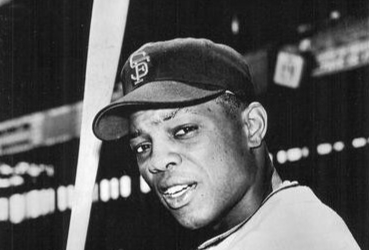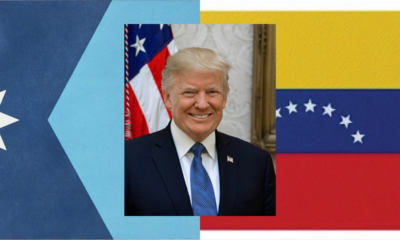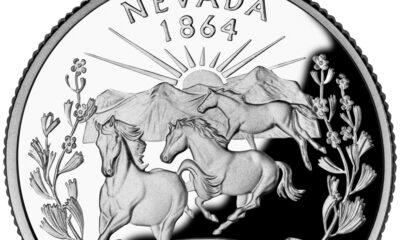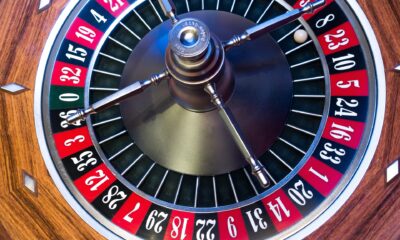Guest Columns
Willie Mays: A Grateful Nation Says Goodbye

How Willie Mays advanced to the Big League
On an October night in 1918, one month after Babe Ruth led the Boston Red Sox to a World Series victory, a successful New York stockbroker named Charles Stoneham came home with some unusual news for his 15-year-old son Horace. “Horrie,” he said, “I bought you a ball club.”
The team was the New York Giants, a prestigious franchise even then, and when Charles Stoneham died in 1936, Horace became the youngest owner in baseball. He promptly set his sights on winning the World Series, which was an elusive quest, and not just for the Giants. New York City had three major league teams then, and one of them, the Yankees, played in the World Series nearly every year (and would win it in 12 of the next 16 seasons).
Center fielder was the sport’s glamour position in those years, and the Yankees’ dynasty featured successive Hall of Fame legends in center field – Joe DiMaggio and Mickey Mantle. But on June 21, 1950 – 74 years ago – Horace Stoneham made a bold move to change the equation. His gambit came in the form of a Western Union telegram to the Memphis offices of African American entrepreneur Tom Hayes.
A successful mortician, Hayes owned many businesses, including the Birmingham Black Barons, a storied team in the Negro American League. The telegram from Stoneham promised Tom Hayes $10,000 for the contract of his youngest star, along with a $4,000 signing bonus for the teenager. His name was Willie Howard Mays Jr.
Who was Willie Mays?
He was the son of Willie Howard Mays Sr., known as “Cat” Mays on the sandlot ballfields of Alabama. Willie Jr. was called “Buck” by his family and friends. His mother was a high school track star and basketball player. Willie averaged 20 points a game on the hardwood and was a talented quarterback on his high school football team. But his destiny was as a center fielder, the position then being defined by the great DiMaggio.
The tight-fisted Hayes apparently kept Stoneham’s $4,000 signing bonus for himself and had no real claim to the $10,000, either: Although 19-year-old Willie Mays was playing for the Black Barons, he hadn’t actually signed a contract in 1950. No matter. The important thing for American history is that Willie Mays was headed to the New York Giants’ farm clubs in Trenton and Minneapolis and from there to immortality.
Red Smith, the great New York sportswriter, once observed that in the 1950s, you could get a fat lip in any New York saloon by starting an argument over which of the city’s center fielders – Mantle, Mays, or Duke Snider of the Brooklyn Dodgers – was the best. “One point was beyond argument, though,” Smith added. “Willie was by all odds the most exciting.”
Amazing statistics
In time, Mays would separate himself from the other two, and from almost everyone who played the game. His amazing stats – .302 lifetime batting average, 660 home runs (despite missing two seasons while in the U.S. Army), 140 triples, 1,900 runs batted in, and 12 consecutive Gold Gloves – put Mays in the middle of the conversation among baseball aficionados about the best player of all time. (That discussion usually comes down to four or five players, the others being Babe Ruth, Ty Cobb, Josh Gibson, and Hank Aaron.)
As impressive as Mays’ statistics are – and baseball has always been a game of numbers – his virtuosity had to be witnessed first-hand to be fully appreciated. In this regard, he reminded old-timers of Ty Cobb. “The greatness of Cobb,” Hall of Famer George Sisler once said, “was something that had to be seen – and to see him was to remember him forever.”
Mastery of the mental challenges
So it was with Willie Mays. His game was epitomized by circus catches in the outfield, clutch hits, flurries of homers, derring-do on the base paths where he racked up 338 career stolen bases. If you looked closely, there was even more. Mays also mastered the mental challenges of baseball. When I was in Little League, my father took me to Giants games and told me to watch Mays carefully even when he wasn’t part of the action. “Look at how he never takes his eye off the ball,” Dad said.
Others noticed, too. “No record book reflects this kind of concentration, determination, perseverance or ability,” San Francisco Chronicle sportswriter Harry Jupiter once wrote. “As a player, Willie Mays could never be captured by mere statistics.”
George Will, who knows more about baseball than any political writer alive, made a similar observation. His Washington Post column this week was headlined “Calling Willie Mays ‘a natural’ was to underrate his craft and smarts.”
Mid-20th century actress and personality Tallulah Bankhead, who was both a Democrat (like Mays) and a fellow Alabamian, put it more colorfully, apparently in an interview with the Chicago Defender, a black newspaper: “There have only been two geniuses in the world,” she said. “Willie Mays and Willie Shakespeare.”
Childhood Dreams
I learned of Willie Mays’ death this week in a text from my sister, one of the few people still around who knew me when we lived in San Francisco as kids. Judy also knew how much Willie meant to me. “I loved that man,” I told her.
“Me, too,” she responded. “He is my earliest baseball memory.”
We aren’t alone. He was my boyhood hero, yes, but many millions of Americans felt his loss just as I did. The tributes to the “Say Hey Kid” have come in from every corner of the country, irrespective of race, generation, geography, or ideology.
“I never dreamed about being president,” George W. Bush liked to tell schoolchildren. “I wanted to be Willie Mays.”
The Democrat who succeeded Bush in the Oval Office was too young to have seen the Giants star play in his prime. Yet while presenting Mays with the Presidential Medal of Freedom in 2015, Barack Obama paid him an equally sublime compliment. “It’s because of giants like Willie,” Obama said, “that someone like me could even think of running for president.”
The New York Post, a conservative tabloid not known for excess sentimentality, checked its tough guy persona at the door this week. “On a diamond up in heaven, they’re cheering Willie, Mickey and the Duke,” a Post editorial declared. “Say hey…Rest in peace, Willie Mays.”
An athlete of athletes
Former basketball star Kareem Abdul-Jabbar, a thoughtful progressive commentator, weighed in as well. “When I was a kid, baseball was my first love and Willie Mays was the reason for that,” Kareem wrote. “The true testament to his greatness for me as a kid was that I deeply admired him even though I was a Dodgers fan and he played for the rival Giants.”
Vin Scully, the Hall of Fame Dodgers play-by-play man said something similar when he met with Mays in person in 2016. “Buck,” Scully said, “you’ve always been my favorite player, even though you wore the wrong uniform.” Mays just laughed.
When he finally hung up his spikes in 1973 at age 42, Mays had been Rookie of the Year, was twice named the National League’s Most Valuable Player, and made 24 All-Star appearances – and was twice named MVP in those games. In the days before cable television and interleague play, All-Star games were the venue where Willie’s talents were on display for the rest of the baseball world to see. He made the most of it. DiMaggio and Mantle seemingly played in the World Series every year, so Mays turned the “midsummer classics” – games played in those days with ferocity – into his showcase.
“They invented the All-star Game for Willie Mays”
“They invented the All-Star game for Willie Mays,” Ted Williams said. Other major league players – All-Stars – felt the same awe in his presence as the fans. Years ago, at the National Press Club, I had a chance to talk to Larry Doby, the second African American ballplayer after Jackie Robinson to break the color line – and the first black player in the American League. Even though I was then a reporter in my 30s, I was briefly transported back in time and posed a kid’s question, not a journalist’s.
“Who was the best player you ever played with?”
“Willie Mays,” he replied softly, recalling an All-Star game in the 1950s when the two men were on the same field. “He was the best I ever saw.”
The National League won 17 All-Star games with Mays in the lineup, losing only six. In 1959, when Mays tripled Hank Aaron home in the 8th inning to give the National League a 5-4 win, San Francisco Chronicle baseball writer Bob Stevens quipped, “Harvey Kuenn gave it an honest pursuit, but the only center fielder in baseball who could have caught it hit it.”
A Sport of Many Hues
If you grew up in New York in the 1950s – or San Francisco in the 1960s (as I did), going to the ballpark was full of anticipation. Games were generally televised once a week and, unless you had money, were viewed on black-and-white television sets. So if you lived in the city, the splendor of the green grass of the baseball field, the bright white uniforms of the home team, and the cacophony of color was like a burst of magic each and every time.
For us, Willie Mays was at the heart of this daily miracle. Your eyes would scour the field or dugout for him. And Willie was as reliable as the mail. Durable and dependable, he’d play all but four or five games a year, hitting third in the Giants’ lineup, swaying menacingly in the batters’ box, patrolling center field like a fighter pilot, running the bases with unfettered panache.
When Willie Mays set the home run record
Mays broke the National League career home run mark on May 4, 1966, a record set by another Giants star named Mel Ott. Invoked mainly as a crossword puzzle answer these days, the left-handed-hitting Ott was a phenom in his era, breaking into the big leagues at 17 when organized baseball’s firmament was ruled by Babe Ruth. Ruth’s reputation has survived the passage of time, modern analytics, and the racial reckoning begun by Jackie Robinson and the great stars of Willie Mays’ generation. But other perceptions have changed. Although Joe DiMaggio insisted on being introduced until the day he died as the “Greatest Living Ballplayer,” it wasn’t really true – because Willie Mays still walked the Earth.
Last night, the San Francisco Giants played the St. Louis Cardinals at Rickwood Field in Birmingham, the diamond where Willie Mays played his first professional games as a teenage phenom for the Black Barons. The homage in one of the oldest cathedrals in the Church of Baseball was planned as a tribute to the Negro Leagues, and MLB did a good job with that. But depending on your theology, Willie’s absence cast a pall over the event – or underscored its sanctity.
In Minneapolis
After leaving Birmingham in 1950, Mays wreaked havoc on minor league pitching in Minneapolis, showing the Giants’ brass that he was ready for The Show before he was 20 years old. He’s too green to cover the massive Polo Grounds center field, some people said. His manager, Leo Durocher, scoffed at that worry, telling sportswriters that Mays would cover the Polo Grounds outfield “like a tent.” Leo the Lip was proven right. In 1951, Mays was Rookie of the Year. By 1954, he was the National League MVP. In that year’s World Series, Mays broke the hearts of Cleveland Indians fans with his famous over-the-shoulder catch of Vic Wertz’s 425-foot fly ball, an iconic play that cemented Mays’ reputation and helped give Horace Stoneham his championship at last.
Mays’ defensive gem, which included an improbably acrobatic throw afterward, is known simply as “The Catch.” Today, you can see its equal on “SportsCenter” on any given week during the season. But ESPN didn’t exist back then, and many people were seeing Mays play for the first time during the 1954 Series. Fans who saw him regularly were already used to this sort of thing. “I don’t know how Willie did it,” Giants’ announcer Russ Hodges enthused on NBC, “but he’s been doing it all year!”
The Giants go to San Francisco
Then in 1958, the Giants pulled up stakes, forsaking New York for the greener pastures of California. The exodus was done in concert with their arch-rivals, the Dodgers, who traded the confines of Brooklyn for the vast possibilities of Los Angeles. It was a complicated passage, prompting varied reactions in all three cities. Millions of New Yorkers felt bereft and bitter. Los Angeles embraced the Dodgers fully – to the point of bulldozing a thriving Mexican American neighborhood to build the team a stadium that still stands.
San Franciscans were a bit too insular and smug for their own good. Some residents of the city thought the Giants should be content playing in Seals Stadium, the Pacific Coast League ballpark at 16th and Bryant streets where the DiMaggio brothers had taken turns patrolling center field. Maybe they were on to something. Seal Stadium was cozy and pleasant. Candlestick Park, built on a landfill near a U.S. Navy shipyard facility and vast housing project, was not. Even in the summer, the sun forgot to shine there for days at a time, fog would roll in off the bay, obscuring the field, the wind would whip in your face. A family trip to the park included ski caps, blankets, and hot cocoa in thermos bottles – in midsummer.
Willie Mays takes on the Dodgers
But in the 1960s, Willie Mays and his teammates could warm you up. So could the rivalry with the Los Angeles Dodgers. The first time I saw a game at Candlestick, it wasn’t cold at all. It was a warm Saturday afternoon. And there was Willie, wearing that numeral 24 on his back, my favorite number to this day, making running catches in center field, bobbing in the batter’s box like a prize fighter, sliding into second as his cap flew off his head. I was smitten with baseball, and it’s been a lifelong love affair.
My boyhood friends and I didn’t know it at the time, but when the Giants left New York for California, Mays and his teammates – many of whom were Latino and black – became part of a larger story. The Giants and Dodgers both decamped to the West Coast just as California was readying to eclipse New York as a cultural and political power in this country. The Dodgers’ Sandy Koufax, Jewish and Brooklyn-born, took to the mellower air of Southern California and blossomed into an unparalleled star. Back East, a generation of young New Yorkers – not all of them Yankees fans – essentially forgot Willie Mays, or pretended to, if only out of self-preservation, and embraced Mickey Mantle and his team of champions instead.
Overcoming prejudice
Meanwhile, San Francisco revealed that it wasn’t yet the cosmopolitan metropolis it aspired to be. There were neighborhoods in “The City” where the color of Mays’ skin made him an unwelcome homeowner. And baseball fans of a certain age compared Mays, not favorably, to their city’s hometown hero: Joe DiMaggio didn’t strike out as much, the old-timers groused. He made tough chances in center field look easy, while Mays did it the other way around.
And yet, kids of my generation in the Bay Area were completely enthralled with Willie Mays and also with Willie McCovey, Juan Marichal, and the Alou brothers. When Mays, McCovey, and Willie Kirkland all started a game in the outfield, no one in our circle noticed that it was three black ballplayers. We were tickled by an outfield with three Willies. (Two years later, in a September game in Pittsburgh, the Giants played three Dominicans in the outfield at the same time. The only noteworthy aspect is that they were brothers: Felipe, Matty, and Jesús Alou).
My point is that what made old-timers grumpy about Willie Mays is precisely what baby boom kids loved about him. We were thrilled as he tore around the diamond theatrically, and we cheered happily when his cap flew off his head as he slid into a base or chased a fly ball.
Supreme ironies
If we had known more about racial prejudice, we would have also seen irony in the adults’ complaint that Mays was “no DiMaggio.” Joe D. may have married the world’s most popular movie star and been toasted by presidents and kings, but he’d come up the hard way himself, and was an ethnic icon in his own right. His nickname on the Yankees wasn’t “Joltin’ Joe” or the “Yankee Clipper,” or any of the names coined by sportswriters. It was “Dago.”
The sixth of seven children born to Sicilian immigrants, DiMaggio dropped out of Galileo High School because he could make more money showcasing his athletic gifts on a baseball diamond than working on his father’s fishing boat as it plied the waters of San Francisco Bay. He could always play, although at the beginning of his career, Joe was so naïve that he could barely function in the public eye.
“I can remember a reporter asking me for a quote, and I didn’t know what a quote was,” he later recalled. “I thought it was some kind of soft drink.” And at first it wasn’t the elites who made DiMaggio such an admired figure; it was everyday Americans, many of them immigrants themselves.
Ironies, continued
“An astonishing portion of the crowd,” the New York Post noted when he first broke into the big leagues in 1936, “was composed of strangers to the sport – mostly Italians – who did not even know the stadium subway station.” They would learn it soon enough. Moreover, DiMaggio attracted similar crowds when the Yankees played on the road.
“I would like to take the great DiMaggio fishing,” Ernest Hemingway’s protagonist says in “The Old Man and the Sea.” “They say his father was a fisherman. Maybe he was as poor as we are and would understand.”
It’s not quite precise to say young baseball fans in the Bay Area in those days didn’t see color. We weren’t blind, and the nation was experiencing race riots even as the civil rights movement changed the face of the country forever. Moreover, there was racial tension on the team itself – most of it directed at manager Alvin Dark, a former U.S. Marine raised in Louisiana – after Dark was quoted making racist comments in a newspaper interview. Dark denied using the language, and Mays convened a players-only meeting to clear the air, but Horace Stoneman (yes, he still owned the team) fired Dark after the 1964 season.
Willie Mays immortalized in song
So, yes, we were certainly aware the Giants roster was stocked with black and Latino players, but they were our favorite players and we were children and knew no other universe anyway. The Giants were our team and we loved them unconditionally. Blindly you could say. “Black is beautiful” seemed less a statement of liberation than an observation of the world as it really was.
In those years, Chuck Berry sang a song, “Brown Eyed Handsome Man,” with one verse that casts the hero as a ballplayer “heading for home.” The line is apparently meant to evoke Jackie Robinson. In a famous jam session, Elvis Presley, Johnny Cash, Jerry Lee Lewis, and Carl Perkins do a version of the song. The tune is catchy, but so is the idea, which proved enduring.
Willie Mays had long retired by 1985 when John Fogerty reprised the “brown-eyed handsome man heading for home” in his song “Centerfield.” Did the songwriter have Mays in mind when he wrote it? Fogerty has always been coy on that point, but he grew up in the Bay Area and embraced the Giants when they moved West. He also knew the Chuck Berry song, and his father was a New York baseball fan. And, not to put too fine a point on it, Jackie Robinson has brown eyes, yes, but so does Joe DiMaggio – and both he and Willie are named-dropped in the song.
Hands Across Time
The facts of the story I’m about to relate come from a respected newsman, author, and presidential biographer. He doesn’t recall if it took place in Seal Stadium, where DiMaggio and his brothers were baseball royalty, or in the newly built Candlestick Park. But this man took his young son, 6 or 7 years old, to a Giants game where they overheard a few fans heckling Mays. Perhaps they compared him in their minds unfavorably to DiMaggio, a man as remote to a child in the 1960s as Ulysses S. Grant. But Willie Mays? How could anyone say anything bad about him? This was sacrilege, a view the little boy expressed aloud. Hearing his lament, a man seated in the row ahead turned around to look at the father and son.
“I’m Matt Carberry, sheriff of San Francisco,” the man said to the father.
“I know who you are, Mr. Carberry,” he replied.
Looking at the boy, Carberry, who knew Mays personally, said, “Would he like to meet Willie?”
As the newsman later told his son, “He might as well have asked if you wanted to meet God.”
Shake the hand that shook the hand…
So the sheriff took the kid down to the dugout, something unlikely to happen just before a major league game today. Trained to be respectful, the boy put out his hand for Mays to shake, which he did, adding a smile and some friendly words. Riding home in the car afterward, the boy was contemplative, and remained so when they arrived at the house. He only spoke when his mother told him perfunctorily to wash up for dinner.
“Are you kidding?” the boy said, casting an incredulous look at his mother while regarding the limb that had touched Willie Mays. “I’m never washing this hand again in my life!”
Quality in Abundance
As you’ve probably guessed, that kid was me. But what I learned this week upon Willie Mays’ death is that millions of Americans – white, black, Latino, Asian – felt the same way about him, and have for a very long time. When 20-year-old Willie Mays was boarding with a family in Harlem while a rookie with the New York Giants, neighborhood kids got to do more than shake Willie’s hand: He would come home from a day game at the Polo Grounds and play stickball with boys in the street. Or sometimes in the morning before a game. Think about that for a moment. New York newspaperman David Hinckley did, and here’s what he came up with:
If you were a 14-year-old New York kid in the summer of 1931, you couldn’t just round up some of your musical pals, knock on Irving Berlin’s window and have Irv come out and write a few songs with you. If you were a 14-year-old aspiring vocalist in the summer of 1941, you couldn’t just grab a couple of tenors, knock on Frank Sinatra’s window and have Frank come join you for a round of harmony. If you were a 14-year-old kid in the summer of 1951, you couldn’t just knock on Willie Mays’ window at 9 o’clock in the morning and have Willie come out and play an hour of stickball with you. Well, actually, you could.
Sometimes those games were followed by a trip to the soda shop where Mays would treat. Can you imagine? Hinckley noted that on Aug. 30, 1951, Willie hit two home runs in one game against the Pittsburgh Pirates at the Polo Grounds, then showered, went to his Harlem boardinghouse, and homered in a stickball game later that day.
And not all of those who adored Willie Mays in the early days were black – or kids. Here’s how 52-year-old Tallulah Bankhead, a diehard Giants fan, worded it in a Look magazine essay she wrote on the eve of the 1954 World Series. After pointing out how the quality of major league baseball had improved after Jackie Robinson broke the color barrier, she added another benefit: “If nothing else, it’s unbigoted some bigots.”
Farewell, Willie Mays
Bankhead then expounded on that idea. “There should be but one requisite for major-league ballplayers, just as there should be but one requisite for an actor or actress-quality of performance,” she wrote. “Quality is what Willie has in abundance.”
For African Americans, the lessons were more direct and more personal. I mentioned Kareem Abdul-Jabbar earlier, too. There was more to what he had to say.
“I am at a point in my life where I want to spend less time mourning the deaths of my friends and heroes and more time celebrating their lives,” he wrote. “As one of the first Black professional baseball players, Willie Mays endured unimaginable hardships. Because of him, I was able to pursue my own sports career and live a better life. Every Black athlete owes him a debt of gratitude. We walk an easier path because he cleared it for us.”
“Even in passing,” he concluded, “Willie has left me with so many wonderful and joyous memories that I can’t help but smile and be grateful.”
Me, too, Kareem. And thank you. There are very many of us.
This article was originally published by RealClearPolitics and made available via RealClearWire.
Carl M. Cannon is the Washington Bureau Chief of RealClearPolitics and Executive Editor of RealClear Media Group. Carl is a past recipient of the Gerald R. Ford Journalism Prize for Distinguished Reporting and the Aldo Beckman Award, the two most prestigious awards for White House coverage. Previous positions include executive editor of PoliticsDaily.com, D.C. bureau chief for Reader's Digest and White House correspondent for both the Baltimore Sun and National Journal. He was a 2007 fellow-in-residence at Harvard University's Institute of Politics, a past president of the White House Correspondents’ Association, and is a published author.
-

 Civilization4 days ago
Civilization4 days agoTrump’s Venezuela Gamble and America’s Shifting National Security Strategy
-

 Civilization4 days ago
Civilization4 days agoOperation Absolute Resolve: Anatomy of a Modern Decapitation Strike
-

 Civilization3 days ago
Civilization3 days agoTen Reasons To Cheer the Arrest of Maduro
-

 Civilization5 days ago
Civilization5 days agoTrump delivers deeds, not words
-

 Civilization1 day ago
Civilization1 day agoOne Fell Swoop: Lawsuit Eyes Death Blow to Racial Preferences
-

 Civilization3 days ago
Civilization3 days agoTrump’s New Executive Order on Space Has the Right Stuff
-

 Executive2 days ago
Executive2 days agoWaste of the Day: $1.6T in Wasteful Spending in Rand Paul’s “Festivus” Report
-

 Guest Columns2 days ago
Guest Columns2 days agoAdvice to Democrats Regarding Maduro Arrest: Resist Reflexive Opposition














